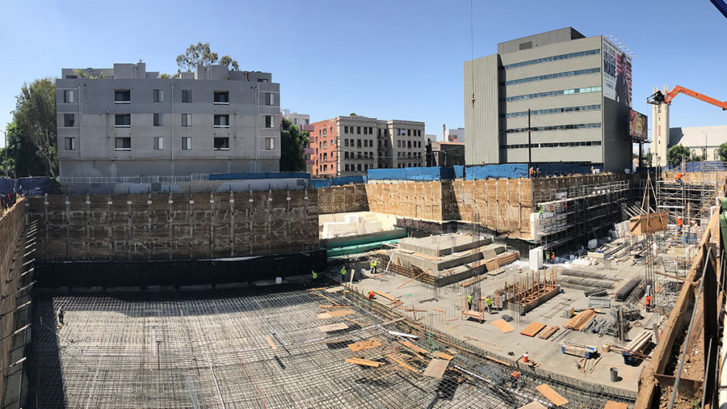Terra-Petra’s Blindside Waterproofing Project featured in Waterproof! Magazine
BLINDSIDE IN HOLLYWOOD
THE FOUNDATION FOR THIS 118-UNIT APARTMENT COMPLEX EXTENDS THREE STORIES BELOW GRADE AND SPANS AN ACTIVE FAULT LINE. GEOFOAM AND BLINDSIDE WATERPROOFING ENSURES IT STAYS DRY.
Blindside waterproofing systems are among the most difficult to design and install. These waterproofing and drainage systems are placed before the structural walls are poured, which means they must be installed over a soil retention system rather than concrete or masonry. That retention system—whether it be lagging beams, sheet pilings, shotcrete, or compacted native soils—is typically rough, uneven, and subsequently requires extensive detailing.
Additionally, blindside applications are usually part of massive projects that extend far below a water table where, in some cases, hydrostatic pressure can be extreme. Here, the workmanship must be flawless, as once the structural wall is in place, it is extremely difficult to repair any leaks that develop.
While blindside waterproofing is a considerably more complex below-grade solution, sometimes it’s the easiest—or only—way to get the job done: Applications of this waterproofing methodology can be found in bored tunnels and deep foundations where over-excavation isn’t possible, for example. Blindside techniques are also optimal when property lines and/or nearby structures limit excavation and access, such as “zero lot line” foundation walls.
This was the case at 1840 N. Highland Ave., a luxury multifamily complex constructed in the heart of Hollywood, California, steps away from the world-famous Hollywood Bowl and Hollywood Boulevard. Typical of many projects in high-density, built-up areas, the 118-unit complex is sited on a tight lot, and extends three stories below grade to create space for mechanical systems and tenant parking; an ideal scenario for blindside waterproofing techniques.
As the schedule moved forward, it transpired that there were several unique complexities, which made the project even more challenging.
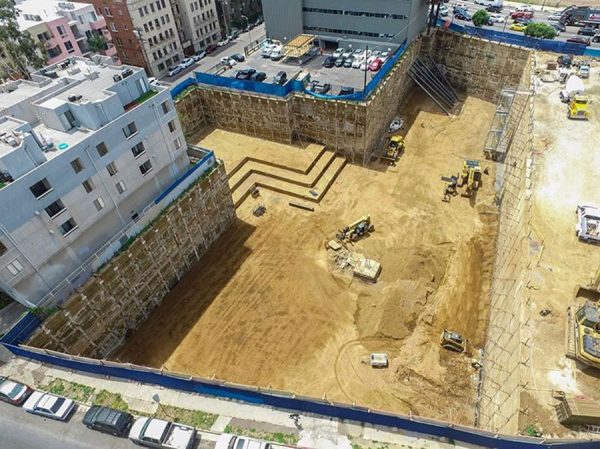
The entire lot was excavated to more than 30 feet below grade, with soldier piles, wood lagging, and rock bolts used to keep the surrounding soil in place.
“There were some real twists to the project, including two fault lines under the cantilever of the building and the water table, which sat at different levels,” says Josh Heidt, with Terra-Petra, the company contracted to provide waterproofing consulting services.
Terra-Petra brought in Epro Services, a Kansas-based waterproofing company with a long history of success on blindside jobs in the state, to provide a solution. Heidt says, “Epro has the kind of case history we were looking for from a manufacturer on a multi-faceted project like this.”
Construction began with a major earthmoving project. The entire 8,144-square-foot lot was excavated to more than 30 feet below grade. Soldier piles and wood lagging were used as a retention system, augmented by tiebacks and soil nails. On one wall, massive tubular steel rakers—more than three feet in diameter—were used to ensure that the foundation of the adjacent seven-story building stayed in place.
To ensure optimal waterproofing, the system had to seal tight despite the irregular substrate and needed to be durable, too. The structural walls would be placed with shotcrete, which would be applied directly to the membrane without a protection course.
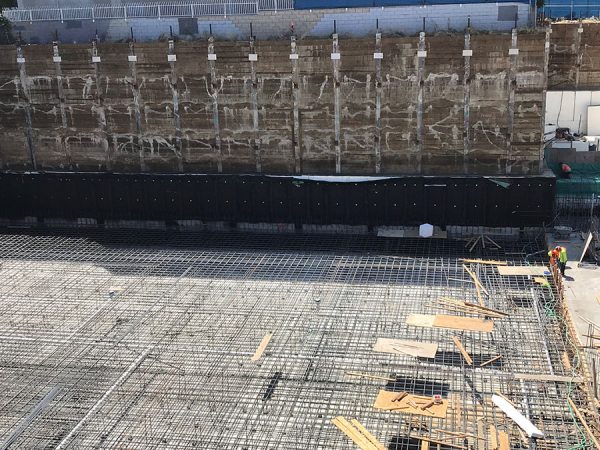
The underslab barrier extends up the wall two feet higher than the water table. The mat of reinforcing steel will be encapsulated in the four-foot-thick foundation
The architect worked closely with the geotechnical consultant and the waterproofing supplier to ensure the specified system would perform as designed. Architect Ronald Rosell, representing the project architect Arquitectonica, says “Epro helped us and the geotechnical consultant work through the issue regarding the north face of the building where the fault line divided the water table.” He continues, “The fault acted like a subterranean waterfall, and Epro gave us recommendations for how best to prevent that hydrostatic pressure and constant flow of water from impacting the structure.”
The general contractor, Frymer Construction, was also brought into these discussions to ensure the design would be buildable. “We collaborated with Terra-Petra regarding the usual qualifications, review of transitions, and fastening and drainage considerations,” says David Frymer, company president.
The bottom of the excavation was about 10 feet below the water table, so crews poured a “mud slab,” then installed the underslab waterproofing system: Epro’s E.Protect+ Underslab, which features built-in layers of redundancy. It’s achieved by combining different types of waterproofing materials to leverage the positive attributes of each, a technique they call “Redundant Field-Installed Composite Design.”
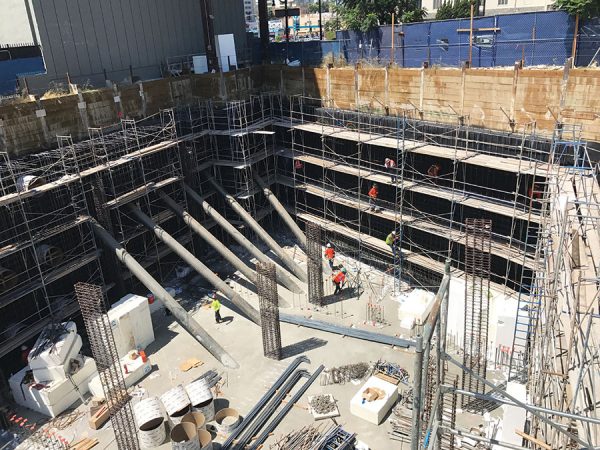
Tubular steel rakers more than three feet in diameter provide support for the lagging and simplify the detailing.
In this particular application, E.Protect+ Underslab was comprised of a layer of 16-mil HDPE thermoplastic membrane with heat-welded seams, over which the team spray-applied a 100-mil layer of polymer modified asphaltic membrane. Finally, this was topped with an HDPE-reinforced bentonite sheet which will expand to seal any leaks that may develop in the future.
This triple system was installed across the slab and up the walls two feet higher than the historic high water table level. Then the structural slab was poured, four feet thick with a double mat of reinforcing steel running 12 inches on center in both directions.
Above the water table, Arquitec-tonica specified E.Proformance Shoring, a blindside waterproofing system used for non-hydrostatic conditions. It’s comprised of a 30-mil HDPE dimpled drain mat installed against the lagging, which was then sprayed with a 60-mil layer of the same asphaltic membrane used in the underslab waterproofing.
The spray-applied coating is formulated so that the heat generated by curing concrete will chemically bond the product directly to the structural wall. The dimples in the drain mat also help prevent delamination between the membrane and the concrete.
E.Proformance was used all the way up to grade level, where it was transitioned to a hot rubber horizontal waterproofing system that was used to seal beneath the planters and the above-grade stucco wall system.
In total, the project used 70,000 sq. ft. of waterproofing.
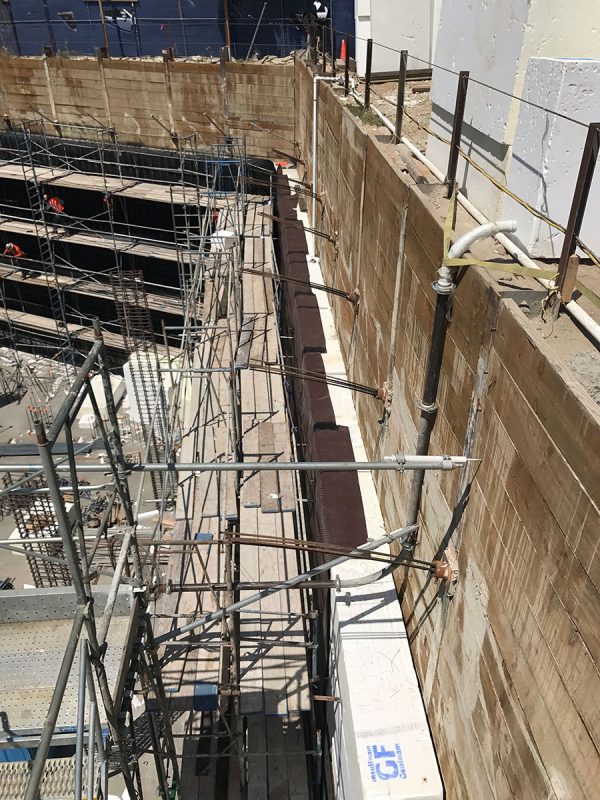
EPS “geofoam,” reduces the effect of seismic movements on the building’s structure and create a smoother substrate for the waterproofing.
Experts say the key to quality in any blindside application is the ability to detail around the soil retention system. This project used an ingenious solution to resolve that dilemma: A two-foot-thick layer of EPS “geofoam,” installed between the retaining wall and the shotcrete structural wall.
Provided by Insulfoam, this rigid insulation arrived in giant blocks and was installed between the retaining wall and the dimple membrane. The geofoam will reduce the effect of seismic movements on the building’s structure and creates a smoother substrate for the waterproofing.
Crews fastened the geofoam directly to the lagging. Then the dimple drain sheet was fastened over the foam, with the waterproofing layer spray-applied to the dimple sheet. The same spray-applied product was also used to detail around the many pipe penetrations, the pits for elevators, and utilities.
“My experience with Epro has been outstanding,” says Mostafa Sobhi, president of BM Builders and the certified Epro applicator responsible for the installation. “Their quick turnaround in answering any concerns and providing details due to changing field conditions has been a huge factor on how jobs like this can be successful, while also maintaining schedules.”
Heidt reports that Epro representatives were “on the site a great deal of the time” to ensure the workmanship was flawless. Despite the high level of complexity and the presence of hydrostatic conditions, working closely with the project team enabled Epro to provide a 15-year no-dollar-limit warranty to the developer.
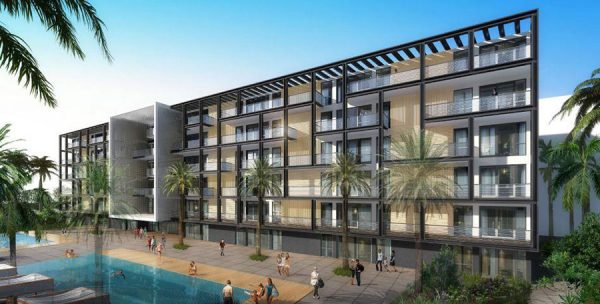
The project at 1840 N. Highland Ave. is scheduled for completion in 2019.
The 1840 N. Highland Ave. apartments are on schedule to be completed in 2019. The development shows that despite the difficulties blindside work presents, with the right materials and know-how, contractors can get excellent results.


